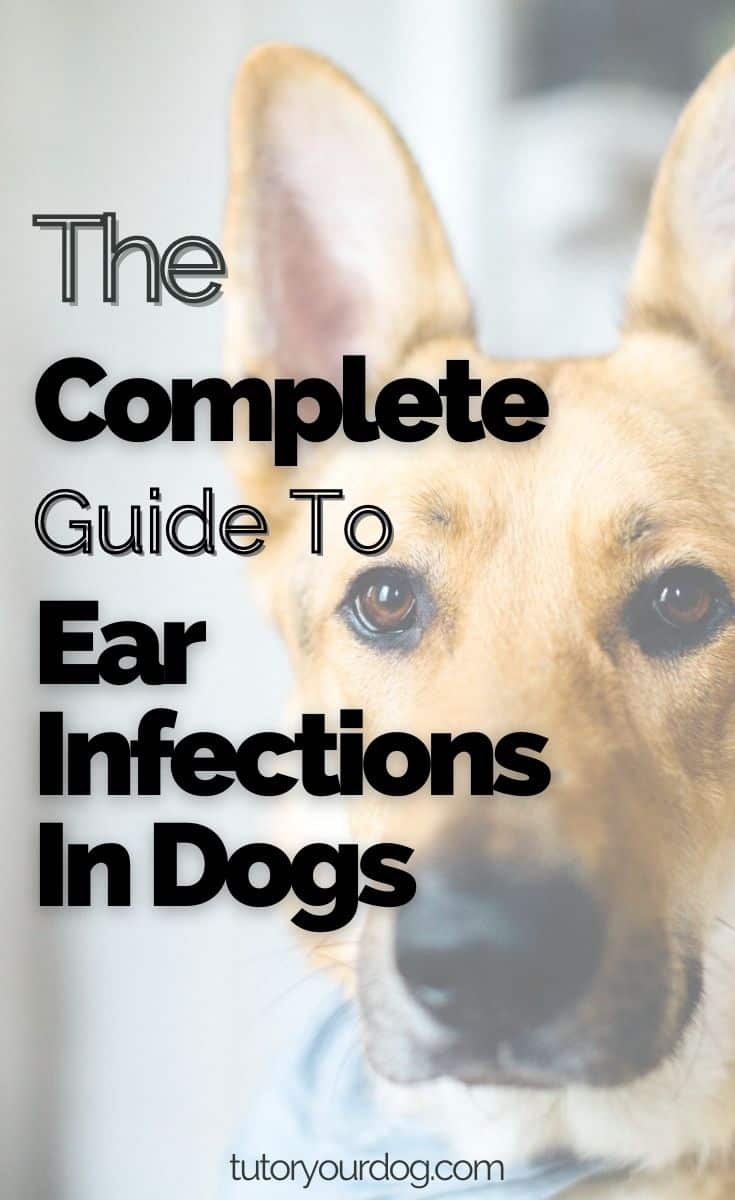{This post may contain affiliate links. This means we may make a small commission at no extra cost to you. This website is a participant in the Amazon Services LLC Associates Program. As an Amazon Associate we earn from qualifying purchases. We only recommend products that we believe will be of value to our followers. Click HERE to see our disclosure for details.}

Ear infections in dogs can be a serious and very painful condition. Learning how to prevent them is important. But if your dog develops one it’s important to learn proper ear infection treatment too.
Signs That Your Dog Has An Ear Infection
These are certain things you may notice if your dog is suffering from an ear infection. If you see your dog do the following things he may have an ear infection.
- Scratching at his ears
- Rubbing his ears
- Holding his head to one side
- Ears are painful to the touch
- Shaking his head
- Bloody, waxy or swollen ears
If your dog has any of these signs, he should be checked out by his veterinarian.

What Happens If The Infection Goes Untreated?
When untreated ear infections progress deeper into the ear. The pain the dog is in increases sharply. The dog may hold his head as still as possible, and to one side. Opening his mouth, or touching his head, will cause him pain. Dogs can also become dizzy, with poor balance and coordination, when the infection progresses to the inner ear. Dogs may walk around in circles, and vomit.

Common Causes Of Ear Infections In Dogs
There are many causes of ear infections. We will discuss some of the most popular causes.
1. Allergies
Ear infections can also be related to skin allergies, especially food hypersensitivity dermatitis and canine atopy. Dogs with these conditions often develop inflamed ears. The dog’s ears become very itchy, which creates an ‘itch-scratch-itch’ cycle. This, in turn, creates scabs around the ear, hair loss, crustiness, and raw skin. The ear canals become filled with a brown wax.
Some dogs are also allergic to some ear medications. A common medication is an antibiotic called neomycin. But they can be allergic to other ear treatment products including cortisone, nystatin, chloramphenicol, thiabendazole, gentamicin, miconazole, and clortrimazole.
Click on the images below to check out our recommended dog care books on Amazon.



2. Grooming Procedures
One thing of concern in dogs that are professionally groomed is the practice of plucking the hair out of the dog’s ear. The serum which then comes out of their pores is an excellent breeding ground for bacteria. This can be a common cause of ear infection. Vets generally don’t recommend that you allow your dog’s ears to be plucked unless their is a good medical reason to do so. An example of a good medical reason is if there is a large mat of hair that is blocking air flow.
How To Remove Matts From The Ear Canal
If the mats of hair are in the ear canal, they should be removed by a vet only. If they’re not, first soak the hair in a coat conditioner for a few minutes to soften it. Then, with your fingers, separate as much of the mat as possible. You may be able to untangle the rest of the mat with a comb, but more likely you’ll need scissors or a mat splitter. Be very careful if you’re using scissors. Using a comb, position it under the mat to protect the skin. Hold the scissors at right angles to the comb, and cut into the matted fur in narrow strips. Very gently, tease the mat out. Then comb out any snarls that are left. Regular grooming, with the right tools, will avoid mats forming in the first place.
Click on the images below to check out grooming supplies on Amazon.



3. Debris That Gets In Your Dog’s Ear
Always check your dog’s ears after he’s been playing in long grass. If you think there is a foxtail in his ear, take him to the vet’s and don’t try and get it out yourself. Fox tails can really damage the ear. If when you press gently on the ear canal he cries out in pain, there’s a good chance there’s a fox tail in there.
Other debris, such as grass seeds and dirt can also get trapped in your dog’s ear and cause an infection.
4. Water In The Ear
If water gets in your dog’s ear canal, bacteria can start to grow. This bacteria can lead to an ear infection. To prevent this from happening, dry your dog’s ears after he swims or has a bath.
5. Build Up Of Wax
A build up of ear wax can cause an ear infection in your dog. Using cotton tips to clean ears, which pushes things further into the ear can also be a culprit.
6. Endocrine Disorders
Certain endocrine disorders such as thryoid disease can make your dog prone to ear infections.
7. Autoimmune Disorders
Autoimmune disorders are when the immune system attacks the cells of the body. Some autoimmune diseases can result in inflammation in the ear which can cause an ear infection.
8. Parasites
Parasites, like ear mites, can cause inflammation in the ear which can then lead to an ear infection.

How Are Ear Infections In Dogs Diagnosed?
If you suspect that your dog has an ear infection it is important to take him to a vet to be diagnosed. It is necessary for your dog’s ears to be examined in detail as this can sometimes reveal the cause of the infection. Your vet will use an instrument called an otoscope to examine his ear.
Depending on the type and severity of the ear infection in your dog, a swab can be taken from inside the ear canal. The swab is used to see if the ear is infected by bacteria, yeast, or some type of organism. Once the ear infection is diagnosed, a treatment can be set up. Identifying the cause of the infection is important to prevent the ear infection from coming back.
How Is An Ear Infection Treated?
Typically, ear infections in dogs are relatively easy to treat. Ear drops are usually prescribed and an ear cleaning solution is often recommended. The ear cleaning solution can be used to break up the wax buildup inside of the ear canal.
If mites are found to be the cause of the ear infection, a spot on product will likely be prescribed to treat the mites. When an allergy is suspected to be the cause of the ear infection, then the cause of the allergy will need to be investigated. If the infection was caused by debris in the ear canal, it will have to be removed. This may need to be done under sedation so that the debris doesn’t get pushed deeper into the ear canal.
Ear infections are a common problem in dogs but with careful treatment, they can typically be cleared up easily without causing your dog too much discomfort.
References:
1. Brian Kilcommons and Sarah Wilson, Good Owners, Great Dogs
2. Richard Pitcairn, Natural Health for Dogs and Cats
3. James Griffin and Liisa Carlson, Dog Owners Home Veterinary Handbook
*Disclaimer: All information presented here is intended for entertainment purposes only. It is not provided in order to diagnose, prescribe or treat any disease, illness or injured condition of the body or pets. The author, publisher, and contributors accept no responsibility for such use. Anyone or their pets suffering from any disease, illness or injury should consult with their physician or veterinarian.







